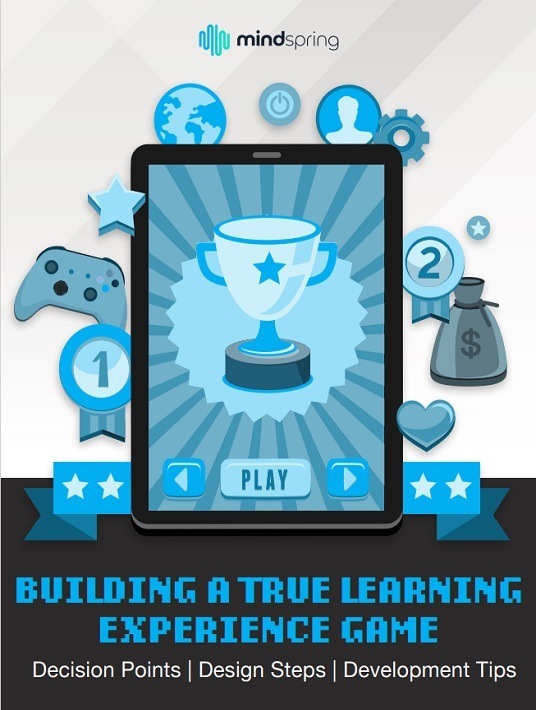Steps Involved In The Serious Game Development Process
This article is part of a series on building a true training game to increase managers’ understanding of corporate finance. What you are about to read is a fable. The company, AshCom, is fictional, but the learning challenges faced by Kathryn, AshCom’s CLO, and her team are real and commonly shared by learning teams in large organizations. It is our hope that you will be able to connect with the characters, their challenges, and the solutions they discover. We also invite you to read the first eBook in the series.

The High-Stakes Project
Looking away from her laptop, Adeena checked the time on her wristwatch. It was the fifth time she had checked in the last 45 minutes. And although it was not quite 4 p.m., she quickly gathered her laptop, a notebook, and her coffee. She was eager to share her thoughts with Kathyrn so that they could move forward with the project. She walked from her cubicle to Kathryn’s office as Kathryn had requested that they meet following the learning team’s discussion on building a true game.
Adeena had only been at AshCom for a little more than a year, but she had come to appreciate Kathryn’s leadership as Chief Learning Officer. Kathryn placed a great deal of trust in Adeena when she asked her to lead the team in a discussion about gamification.
Adeena knew that the stakes were high on the project Kathryn had asked her to lead. The learning team had been tasked with creating a learning experience that would increase financial literacy for the management team of the 7,000-person company. As if that wasn’t enough, the request came from Kurtis, the Chief Financial Officer. He described this learning as “mission-critical.”
Increasing Financial Literacy
The drive to increase financial literacy came from Kurtis thinking about hundreds of managers making thousands of decisions every week that had a profound impact on AshCom’s financial performance. Kurtis was not confident that his managers truly understood corporate finance or how they could contribute to it despite the training opportunities that were provided in the past. His only suggestion was that some kind of competition might get the managers more engaged and interested.
Kathryn asked Adeena to do the research on games and present her findings to the other six members of the learning team. The team had already held two meetings of 90 minutes each to get their heads around Kurtis’ request and how gamification might be part of the solution. Both meetings went exceptionally well.
At the end of the second meeting, the team was asked to vote on some generic concepts around building a true game. The consensus was just what Kathryn hoped for. Her summary statement at the end of the meeting was, “We are going to build a true game for hundreds of managers at AshCom with the goal of teaching them how corporate finance works. The game will combine strategy and role-playing using the key motivators of ownership, accomplishment, and social influence.”
Game Development Process: Figuring Out The Next Steps
As the meeting broke up, Kathryn asked Adeena to stop in her office at 4 p.m. Adeena arrived a few minutes early.
“I want you to know,” said Kathryn, “that your thought leadership and presentation on games were remarkable. Our learning team is generally pretty unified, but I was really impressed with how quickly they all gelled around the same solution.”
“Thank you,’ said Adeena. “I am honored by your trust in me to lead this so far.”
“I’m glad to hear you say that,” replied Kathryn, “because I want you to lead this effort going forward. You are on point here if you are willing to take on this project. I know it will be months of work. I also know you understand its importance.”
“I certainly do,” replied Adeena. “The words ‘mission critical’ haven’t left my mind.”
“I know we have consensus around the type of game we want. It makes sense that the structure should be a combination of strategy and role-playing. I also agree that the key motivators will be social influence, accomplishment, and ownership. I think our management team will respond well to this type of game.”
Kathryn continued, “I wanted to meet privately with you to discuss the next steps. I have so many questions, and I’m not sure I fully understand what should happen now. I also wonder who will actually build this game? We don’t have the software skills or experience to do it on the learning team, and I’m sure our IT department won’t be of much help. We will need someone who has done this before.”
“And whoever we pick to build this will need to know not only how to build a game but also learning science so that it accomplishes what we need it to do,” said Adeena continuing Kathryn’s thought.
Creating A List Of Questions
“Before we get to the ‘who’ question, I think we have more decisions to make as a learning team,” continued Adeena. “I don’t know that we need to answer them all immediately, but I think we need to get a list of questions or decision points.”
“Sounds like you have some specifics in mind,” replied Kathryn.
“Much of this won’t get resolved until we bring on an experienced vendor,” said Adeena, “but we can start with some and add to them as we need to. Mind if I use your whiteboard? I’m a visual person and seeing things on a board really helps me get the whole picture.”
“Of course,” said Kathryn. “That’s why it’s there. You can erase everything on it so you start with a truly clean slate.”
Goals, Mechanics, And Rules
“For proper game design, we need to think about these five things at the start,” said Adeena as she began to write on the whiteboard. “Every game must have a Goal. The players have to have something to achieve. This ties to the accomplishment, social influence, and ownership motivator.”
“The second,” continued Adeena, “is Mechanics. This is how the game will function and how learners will play it. Will they play as individuals or as teams? Will they play against the game itself or against other individuals and teams?” She wrote “Mechanics” on the whiteboard.
“The third is the Rules. Every game has a set of rules and players need at least a basic understanding of them. Think of the times you’ve played a new board game. If the rules are too complicated or not clear, chances are you will become frustrated and stop playing.” She wrote “Rules” on the whiteboard.
“Yes,” said Kathryn. “I can think of several times when we’ve tried to play a new game with our kids where something like that happened.”
In-Game Decision Points And Feedback
“Next is Decision Points,” said Adeena. “We’ve decided to create a strategy game so we will need the players to make decisions throughout the game. Ideally, they build on one another. For really good strategy games, players don’t get immediate feedback on whether or not they made the right decision. Like life, many small decisions lead to certain conclusions. Some are easier. Some are more difficult. But they all lead to a specific conclusion. I think this will be important in teaching financial literacy because it sounds like this is what is most important to Kurtis.” IMAGE
“That’s a great point,” replied Kathryn. “Getting the management team to see how small everyday decisions lead to big consequences that can be good or bad over a longer period of time.”
“Exactly,” said Adeena. “That ties into the last critical element. Learners in a game need some system for Feedback. This is especially important for games that teach. They need to have a sense of where they are in the game and how they are doing compared to the goals that have been set for them. Sometimes feedback is funny and sometimes more serious. It is usually best in real-time like when a game contains live data. But sometimes you don’t know how you are doing until the end.”
“I haven’t played a lot of video games,” said Kathryn, “but I know what you mean. I’ve seen my kids play, and there is usually some kind of score or health gauge off to the side.”Kathryn continued, “I have some things I need to add to the list that I ask with every learning project we do. We need to get deeper clarity on our learning objectives for this game. I know the overall goal is to increase financial literacy, but we need to get more granular. What do we want learners to know once they’ve completed the game? What do we want to be able to do? What attitudes or behaviors are we trying to change? I think we could move through these fairly quickly, but I want to get Kurtis involved in this early so we are sure our objectives match his.”
Developing Learning Objectives
“I agree,” said Adeena. “It is tempting to get so excited about the game that we overlook solid learning objectives. We have to think about the proficiency level we want for each of these objectives.”
“And, of course,” said Kathryn, “I have to think about budget, staffing, timing, and bringing in a partner to help us answer these questions and actually build the game.”
“One more thing to add,” said Adeena. “We need to develop a plan for how we are going to test what we build. New games are notorious for glitches that bring players to a dead end. There will be bugs. Everyone needs to know this at the start.”
“And,” said Kathryn, “we should think about how we are going to market this learning experience to the management team. People who love games will be intrigued by this approach, but I’m sure some will roll their eyes when they hear we are asking them to play a game on financial literacy.”
“For sure,” said Adeena. “I love games but that might be my first reaction to hearing of a game on corporate finance. We need to put some serious effort into marketing ideas.”
How To Find The Right Partner
Adeena continued, “I want to circle back to something you mentioned just now: finding a partner or vendor to help us work through this. I agree that we don’t have the experience or resources to do this in-house. What should we be looking for and who should begin the search?”
“As I said at the beginning of this conversation, I’m asking you to lead this project, so my quick answer is that you lead the search and bring me your top two or three suggestions with some sense of cost. Because this is new to us, I have no real sense of the potential price.”
“I don’t either,” said Adeena, “but I’m sure I can get that information. Can we talk a little about what I should be looking for? There are lots of companies that build games. But I wonder how many of them know learning science and will understand that this will be distinctly designed as a learning experience?”
“OK,” said Kathryn. “Let’s set a couple of parameters which will save you some time. The first is simple. The vendor needs to have experience building games. They need to be technically innovative.”
“The second follows on what you just said. They need to understand the best of learning science because that is the core of what we are trying to do.”
“I would add another,” said Adeena. “They need to be creative. Even exceptionally creative.”
“Three things. Makes sense,” said Kathryn. “I suspect this will narrow the list of possibilities pretty quickly. We need a partner with game experience who is able to create world-class learning experiences using exceptional creativity, the best of learning science and innovative technology.”
Kathryn walked to the whiteboard and wrote, “Experienced, Creative, Learning Science, Technology.”
“I assume we remain in charge of the instructional design, objectives, and learning components?” asked Adeena.
“Of course,” said Kathryn, “but I would hope the partner we choose can help in this area. We don’t want to be teaching them learning science as we move forward. They need to appreciate great instructional design and learning experiences.”
Looking at her watch, Kathryn realized it was past 5:30. “I’ve certainly taken a lot of time at the end of what has probably been an intense day for you. Please start your search as the first step. I think we have enough direction to engage the right partner.”
“I will get started tomorrow first thing,” said Adeena, “and will let you know what I find.” Kathryn smiled at this and wished Adeena a goodnight.
Conclusion
To read the rest of the chapters in this series on building a true game to teach financial literacy and to see Kathryn and her team solve their challenges, please download the eBook Building A True Learning Experience Game: Decision Points, Design Steps, And Development Tips. Also, join the webinar for more insights to build a true game that wows your online learners.








